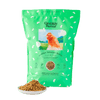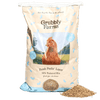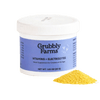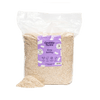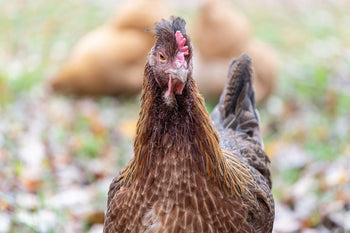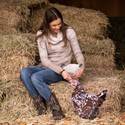Egg binding is a serious condition that can mean death for a laying hen. It essentially stops up all the body functions and causes extreme stress and pain for the hen. Being able to recognize a hen suffering from egg binding is essential for helping the hen as soon as possible. With proper care, an egg bound hen may be able to recover. It is also important to know what causes egg binding and how you can prevent it in your backyard flock.
What is egg binding?

Egg binding, also known as oviduct impaction, occurs when an egg gets stuck in the cloaca and is unable to be laid. An egg bound chicken can quickly go into shock and die from egg binding. When an egg gets stuck in the cloaca, unlaid eggs can build up behind the stuck egg and cause the hen’s abdomen to swell. The stuck egg also inhibits the hen from expelling feces, which then leads to constipation and even infection from non-expelled body waste.
Old age, poor genetics, and improper nutrition can all cause a hen to be more prone to being egg bound. However, there are several causes for egg binding even in healthy, young laying hens:
Large Eggs - Eggs that are abnormally large for the hen can lead to egg binding. This can happen if a pullet starts laying too soon or with double yolker eggs.
Odd Eggs - Eggs that are not the normal oblong, oval shape of a traditional egg can get stuck in the cloaca and cause oviduct impaction. Odd-shaped eggs can be a result of injury, age, genetics, disease, or diet.
Old Hens - As hens get older, their reproductive system naturally slows down and the muscles needed for laying an egg lose tone and get weaker, which can contribute to egg binding if the hen can’t expel the egg.
Fat - Hens that are overweight are more prone to egg binding. The extra fat puts pressure on the muscles needed for laying an egg.
Extreme Cold - Extremely cold temperatures can cause a hen’s muscles to get stiff which inhibits the normal contractions of the muscles during egg laying.
Calcium Deficiency - Calcium is needed to stimulate the muscle contractions used during egg laying. A calcium deficiency can lead to egg binding issues. Older hens or extremely good layers may have depleted calcium reserves that make them more prone to egg binding. Consider a calcium supplement to avoid a deficiency.
Disease - Disease, infection, or parasites can cause the oviduct to swell or cause malnutrition which would inhibit proper laying.
Genetics - Hens can be genetically pre-disposed to egg binding depending on the breed or strain. Production and hybrid breeds are more prone to being genetically pre-disposed to egg binding.
Holding in an Egg - Sometimes a hen can become egg bound if she holds in an egg that is ready to be laid if she can’t find a suitable nesting spot.
Understanding the Anatomy of Egg Laying
Let’s take a quick look at a hen’s reproductive system so you can get a better understanding of how egg binding affects the laying process. Within an unhatched egg, a female embryo will develop her left ovary and oviduct. These are the main two organs responsible for reproduction in a female chicken. The ovary consists of a cluster of many undeveloped yolks, called ova. A hen will never run out of ova during her productive life.
Once the female chicken is mature, hormones will trigger the ovary to release one mature ova into the oviduct. During a laying cycle, each ova is released about an hour after the last ova, which causes a hen to lay her egg about an hour later each day. A double yolk egg occurs when two ovas are released within a short amount of time of each other.
A released ova enters the first part of the oviduct called the infundibulum. At this point, if there is sperm present from the hen mating with a rooster the ova will be fertilized. From there it moves into the oviduct magnum where it is encased in albumen, or egg whites. Then it moves into the oviduct isthmus where the ova and albumen are encased in several membranes.
The partially formed egg then moves into the uterus where it is sealed in a calcium-rich eggshell. The shell is coated in a thin, protective coating in the vagina right before it passes into the cloaca to be laid. This protective coating is often called the bloom or cuticle of an egg. The whole process from ova release to bloom coating takes about 25 hours.
The point at which egg binding may occur is right before the egg is laid. When an egg is shaped in the uterus, the pointy end comes first to proceed through the rest of the egg forming process. Once the egg has been coated in a bloom, the egg is then rotated by muscle movements so that the blunt end of the egg comes out first when the egg is laid. This rotation process is where egg binding can occur. Usually if an egg gets stuck in the rotation process, you may not be able to see the egg even if the hen is exhibiting symptoms of being egg bound.
A hen can also become egg bound right before the egg is pushed out. The muscle contractions that are intended to push the egg out of the cloaca may not be strong enough to finish the laying process. You can usually see the blunt end of the egg if a hen gets bound at this stage.
A blockage of more than 24 hours can cause another egg to build up behind the stuck egg.
Symptoms of Egg Binding

Egg bound chicken symptoms are fairly easy to recognize, however, you must be careful not to mistake them for other signs of illness or disease. Egg binding is often characterized by a sudden onset of symptoms. Usually, an egg-bound hen will be exhibiting two or more of the following egg-bound symptoms:
- Distended abdomen
- Straining
- Decreased activity
- Decreased appetite
- Visible egg
- Swollen vent
- Abnormal droppings or lack of droppings
- Restlessness
- Signs of discomfort
- Penguin-like walk
- Frequent vocalization/distressed sounds
If you are unsure if a hen is egg bound and you can’t visibly see part of the egg, you can gently feel inside the hen’s cloaca for an egg. Do so by lubricating your finger with olive oil and carefully inserting it into the hen’s vent. Feel around in the cloaca for the presence of a hard eggshell which would mean the hen is egg bound. Be careful not to stretch or break the delicate skin of the vent when you are feeling for the egg.
Similar conditions that can be mistaken for egg binding include ascites, cystic right oviduct, infected uterus, internal laying, or egg peritonitis. Cystic right oviduct can be caused by another illness or disease as well.
Steps to Support an Egg-Bound Chicken
Once you have diagnosed a hen as being egg-bound, you should take immediate action to help the hen. The longer a hen is egg bound, the less chance she has to fully recover from the condition. Here is the care an egg-bound hen should receive immediately upon diagnosis:
Step #1. Quarantine- Move the hen into a separate space away from the rest of the flock. Ideally the location should be dimly lit, quiet, and warm. The low lighting can help mimic a nesting area and the warmth can help her relax and possibly lay the egg. A good standard to go by is keep the quarantine area between 60-65°F. Make sure the area has soft litter for nesting (like large flake wood shavings or straw) and the hen can access food and water if she desires.
Step #2. Hydration- Encourage the hen to drink water to help her stay hydrated. Adding electrolytes to her drinking water can help keep the electrolytes in her body balanced during this time of stress. Avoid adding supplements to the hen’s water that could cause her to stop drinking due to the flavor of the water.
Step #3. Nutritional Support- While an egg-bound hen may not be too interested in food, make sure she at least has the option to eat. Supply the hen’s normal layer feed in an easy to access spot. You can also offer the hen calcium-rich foods.
Calcium promotes proper muscle contractions for pushing out the egg. While crushed tums and vitamin supplements can be offered, using calcium concentrate is the most effective way to supplement calcium. Adding calcium concentrate to the hen’s food or water is the easiest way to help the hen get more calcium into her diet when she is egg-bound. Offering calcium supplements prior to a warm water soak can be beneficial too.
Treatment Options for Egg Bound Chickens
Once the hen is settled in her quarantine area, you should consider some egg-bound chicken treatment options. Here are several ways to help an egg-bound chicken:
Non-invasive Option
A non-invasive way to treat an egg-bound hen is to use warm water soaks and gentle massages to help the hen pass the egg on her own. A warm water bath should involve water that is about 75-80°F and 1 cup of Epsom salts. The warm water and salts will help relax the hen’s muscles. Make sure the water is deep enough so that the hen’s vent is submerged in the water. A warm water soak should last no longer than 15-30 minutes.
Remove the hen from the water and gently dry her off with a soft towel. Keep her in a warm location while she finishes drying. You can repeat the warm water soaks in 1 hour increments if you see no signs of improvement.
In conjunction with the warm water soaks, you can also massage the egg externally. An external massage would involve gently massaging the hen’s abdomen to help maneuver the egg into a proper position for laying. Do not apply a lot of pressure or try pushing on the egg externally. You don’t want the egg to break while it’s still inside the hen and you don’t want to push the egg out and cause pro-lapsed vent or vent tears.
Lastly, after the warm water soak, you can lubricate around the hen’s vent and cloaca to encourage easy passage of the egg. You can use petroleum jelly, olive oil, warm saline solution, poultry wound wash, or soapy water to lubricate around the hen’s vent.
Veterinarian Interventions
If the hen cannot pass the egg on her own, a visit to the vet may be in order. A veterinarian can do an X-ray to confirm that the hen is egg bound. They can also administer calcium supplements in the proper dosage or use hormonal injections to encourage muscle contractions for the egg to be laid.
Manual or Surgical Intervention
If the egg still hasn’t been laid, it may be time to consider last-resort efforts to save the hen’s life. A manual or surgical intervention may be necessary to prevent the hen from going into shock or getting blockages that can lead to infection.
Use a large-bore needle syringe to puncture the eggshell and carefully syringe out the contents of the egg. An 18-guage or lower needle will be ideal for removing the egg contents in a timely manner. Once the egg has been emptied, you can carefully break the eggshell by using a lubricated finger inserted gently into the hen’s vent. Don’t try to break the egg externally by pressing on the hen’s abdomen.
Try to keep the shell membrane intact to prevent eggshell shards from breaking away into the cloaca. Shell shards can injure the hen and lead to internal infection. Once the eggshell is collapsed, you can gently begin removing the eggshell. Use lots of warm saline water or soapy water to keep things lubricated and warm. Rinse away smaller fragments but make sure the water doesn’t wash small shards further into the cloaca.
Don’t worry if there are a few small pieces of eggshells that you can’t get out. Those should hopefully be passed out when the hen defecates or lays her next egg. Sometimes a hen can even pass a collapsed eggshell without assistance if given some time to relax.
Monitor the hen for swelling around her vent or for prolapsed vent which can occur after a surgery. Let the hen rest undisturbed as much as possible. If you suspect infection due to a blockage or eggshells stuck in the cloaca, treat the hen with antibiotics.
It may take several days or weeks for the hen to fully recover and be ready to rejoin the flock. Once the hen is eating, drinking, and behaving like normal she can be re-integrated back into the flock. A hen who has survived egg-binding will be more prone to reproductive issues and future cases of egg-binding.
Preventing Egg Binding
Preventing egg binding in your flock is a great way to keep your hens healthy and to avoid the serious condition an egg-bound hen presents. Here are some ways you can prevent egg binding in laying hens:
Nutrition
Make sure your laying flock is getting a properly formulated layer feed. Layer feed is specifically formulated for laying hens with the proper nutrition and calcium in the feed. You should also make sure your flock’s diet stays balanced by monitoring treats and only offering healthy snacks. When a hen consumes too many treats, it can offset the nutritional balance of her feed and lead to deficiencies.
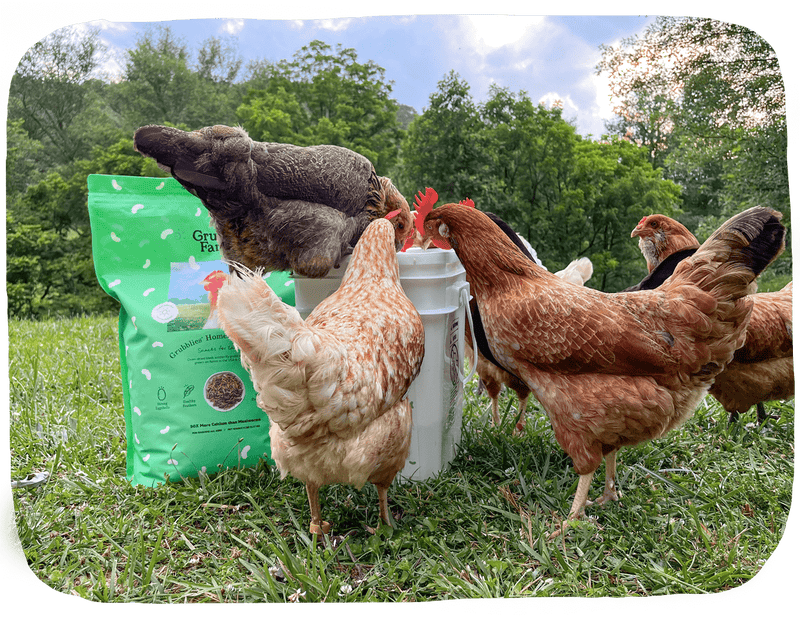
Grubblies
A healthy treat for your flock
With 50x more calcium than mealworms, treat your flock with Grubblies and help support strong eggshells.
Shop Now
Supplements
Your flock should also have access to free-choice calcium supplements. Crushed eggshells are often offered as an economical calcium supplement, but the eggshells must be mixed with another source of calcium like crushed oyster shells. Eggshells pass through the digestive system too quickly to provide a substantial calcium supplement to the diet. Crushed oyster shells are metabolized slower and provide a more substantial source of calcium. You can offer calcium supplements in a feeder separate from your flock’s layer feed. The hens will eat supplemental calcium based on their individual needs.
Avoid giving your flock apple cider vinegar during the summer months. Apple cider vinegar uses up calcium reserves when it is digested by a hen’s body. During the summer, calcium consumption may already be decreased due to heat and heat stress can inhibit calcium absorption as well.
Monitoring Egg Production and Size
Make sure you keep your laying flock on a healthy laying schedule. Young pullets should not be exposed to extended daylight hours which can cause them to start laying too soon. The nesting boxes in the chicken coop should be dark and private to encourage hens to lay in the boxes and not hold in an egg. Supply one nesting box for every 4-5 hens so that the hens don’t have to wait in line or search for other nesting areas.
If you know a hen is likely to lay large eggs, keep an eye on her health and wellness. Select heritage or landrace chicken breeds who don’t tend to have a genetic pre-disposition to egg binding.
Regular Health Checks & Veterinary Care
You can also perform regular health checks on your flock to make sure they are staying healthy and parasite free. If necessary, take any ailing hens to a veterinarian for proper diagnosis or treatment. Treating illnesses or parasites as soon as possible can help prevent damage to a hen’s reproductive system.
Frequently Asked Questions About Egg Bound Chickens

How common is egg binding in chickens?
Egg binding is most common in older hens and in production chicken breed strains. Any laying hen can become egg bound, however, birds who are bred for high egg production tend to have more reproductive health issues. Egg binding is not a rare or uncommon condition in laying hen flocks.
Can egg binding be fatal?
Yes, egg binding can be fatal for a hen. If the condition is not fixed within 36-48 hours of occurring the hen can die from shock or infection. Egg binding caused blockages in the reproductive and digestive systems which can lead to death.
Is egg binding preventable?
Yes, you can prevent egg binding in your flock by making sure they get a balanced, nutritious diet and daily care. Good breeding practices and regular health care can help a flock stay healthy and productive.
How long can an egg-bound chicken survive without treatment?
An egg-bound chicken can usually last no longer than 24 hours without treatment. If a hen cannot pass the egg on her own within 24 hours she is in risk of going into shock.
What should I do if I suspect my chicken is egg bound?
If you suspect a hen is egg-bound, the surest way to make an accurate diagnosis is to feel for the egg within the hen’s cloaca. Do so by gently inserting a lubricated finger into the hen’s vent and feeling for the egg. Once the condition has been diagnosed, begin immediate treatment for the hen. The faster the hen can pass the egg, the more likely she will be able to recover from the condition. You can also take the hen to a veterinarian for immediate treatment.
Conclusion:
Egg binding can be a fatal condition for a laying hen. Learning how to recognize and treat egg binding in a hen can help you raise a healthy, productive flock. Ensuring your flock is fed a balanced diet and has adequate access to dark, quiet nesting places can help prevent egg binding from becoming a problem in your flock. If you suspect one of your hens is in danger from egg-binding, make sure you start treatment immediately or get professional help from a veterinarian to help her safely recover!
